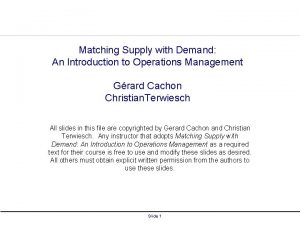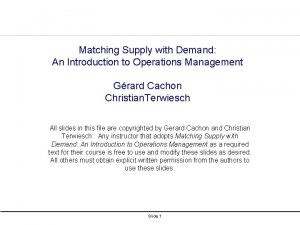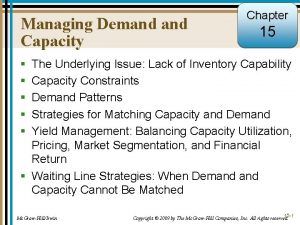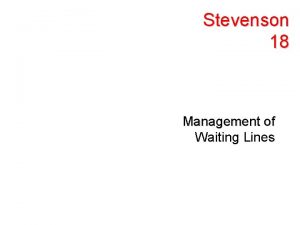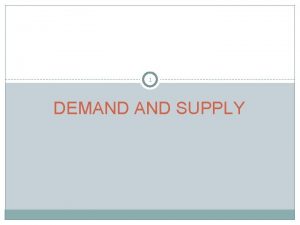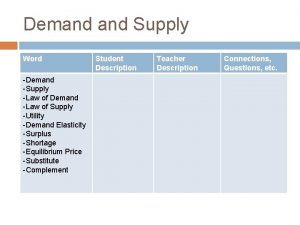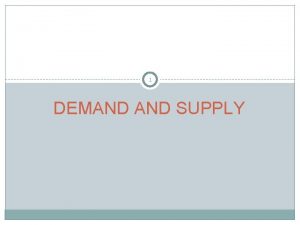Managing Supply and Demand Strategies for Matching Supply












- Slides: 12

Managing Supply and Demand

Strategies for Matching Supply and Demand for Services DEMAND STRATEGIES Developing complementary services Developing reservation systems SUPPLY STRATEGIES Partitioning demand Sharing capacity Establishing price incentives Crosstraining employees Promoting off-peak demand Using part-time employees Yield management Increasing customer participation Scheduling work shifts Creating adjustable capacity

Partitioning Demand at a Health Clinic Smoothing Demand by Appointment Scheduling Day Monday Tuesday Wednesday Thursday Friday Appointments 84 89 124 129 114

Discriminatory Fee Schedule for Camping Experience type 1 2 3 4 Days and weeks of camping season Saturdays and Sundays of weeks 10 to 15, plus Dominion Day and civic holidays Saturdays and Sundays of weeks 3 to 9 and 15 to 19, plus Victoria Day Fridays of weeks 3 to 15, plus all other days of weeks 9 to 15 that are not in experience type 1 or 2 Rest of camping season No. of days 14 Daily fee $6. 00 23 2. 50 43 0. 50 78 free EXISTING REVENUE VS PROJECTED REVENUE FROM DISCRIMINATORY PRICING Experience type 1 2 3 4 Total Existing flat fee of $2. 50 Campsites occupied Revenue 5. 891 $14, 727 8, 978 22, 445 6, 129 15, 322 4, 979 12, 447 25, 977 $ 64, 941 Discriminatory fee Campsites occupied (est. ) Revenue 5, 000 $30, 000 8, 500 21, 250 15, 500 7. 750 …. …. 29, 000 $59, 000

Hotel Overbooking Decision Matrix Number of Reservations Overbooked No. Probshows ability 0. 07 1. 19 2. 22 3. 16 4. 12 5. 10 6. 07 7. 04 8. 02 9. 01 Expected loss, $ 0 0 40 80 120 160 200 240 280 320 360 121. 60 1 100 0 40 80 120 160 200 240 280 320 91. 40 2 200 100 0 40 80 120 160 200 240 280 87. 80 3 300 200 100 0 40 80 120 160 200 240 115. 00 4 5 400 500 300 400 200 300 100 200 0 100 40 0 80 40 120 80 160 120 200 164. 60 231. 00 6 600 500 400 300 200 100 0 40 80 120 311. 40 7 8 9 700 800 900 600 700 800 500 600 700 400 500 600 300 400 500 200 300 400 100 200 300 0 100 200 40 0 100 80 401. 60 497. 40 560. 00

Tellers required 2 3 4 5 6 7 Scheduling Part-time Bank Tellers required 0 1 2 3 4 5 Decreasing part-time teller demand histogram 0 1 Two Full-time Tellers Mon. Tues. Wed. Thurs. 5 4 3 2 1 1 5 2 Fri. Mon. Wed. Thurs Fri. DAILY PART-TIME WORK SCHEDULE, X=workday Teller 1 2 3, 4 5 Mon. x x x …. Tues. …. …. Wed. x …. …. x Thurs. …. x …. …. Fri. x x Tues.

Daily Scheduling of Telephone Operator Workshifts Topline profile Scheduler program assigns tours so that the number of operators present each half hour adds up to the number required Tour 12 2 4 6 8 10 12

Weekly Workshift Scheduling with Days-off Operator 1 2 3 4 5 6 7 8 Total Required Excess Su x … … … x 6 3 3 M x x. . . … … 6 6 0 Schedule matrix, x = day off Tu W Th … … … x x … … … x … … … 5 6 5 0 0 0 F … … x x x … 5 5 0 Sa. . . … … … x 7 5 2

Percentage of capacity allocated to different service classes Seasonal Allocation of Rooms by Service Class for Resort Hotel First class Standard Budget 30% 20% 50% 20% 30% 20% 50% 60% 10% Peak (30%) Summer 30% Shoulder (20%) Fall 50% Off-peak (40%) Winter 30% Shoulder (10%) Spring Percentage of capacity allocated to different seasons

Ideal Characteristics for Yield Management u Relatively Fixed Capacity u Ability to Segment Markets u Perishable Inventory u Product Sold in Advance u Fluctuating Demand u Low Marginal Sales Cost and High Capacity Change Cost

Demand Control Chart for a Hotel Expected Reservation Accumulation 2 standard deviation control limits

Yield Management Using the Critical Fractile Model Where x = seats reserved for full-fare passengers d = demand for full-fare tickets p = proportion of economizing (discount) passengers Cu = lost revenue associated with reserving one too few seats at full fare (underestimating demand). The lost opportunity is the difference between the fares (F-D) assuming a passenger, willing to pay full-fare (F), purchased a seat at the discount (D) price. Co = cost of reserving one to many seats for sale at full-fare (overestimating demand). Assume the empty full-fare seat would have been sold at the discount price. However, Co takes on two values, depending on the buying behavior of the passenger who would have purchased the seat if not reserved for full-fare. if an economizing passenger if a full fare passenger (marginal gain) Expected value of Co = p. D-(1 -p)(F-D) = p. F - (F-D)
 Matching supply and demand in supply chain
Matching supply and demand in supply chain Five domestic tourism market segments
Five domestic tourism market segments Matching supply with demand
Matching supply with demand Matching supply with demand
Matching supply with demand Module 5 supply and demand introduction and demand
Module 5 supply and demand introduction and demand Tactics for matching capacity to demand
Tactics for matching capacity to demand Managing capacity and demand
Managing capacity and demand Mainwaring strategies for managing conflict
Mainwaring strategies for managing conflict Waiting lines operations management
Waiting lines operations management Fiscal measures to correct deficient demand
Fiscal measures to correct deficient demand Dependent demand
Dependent demand Uri ng kurba
Uri ng kurba Demand estimation and forecasting
Demand estimation and forecasting


